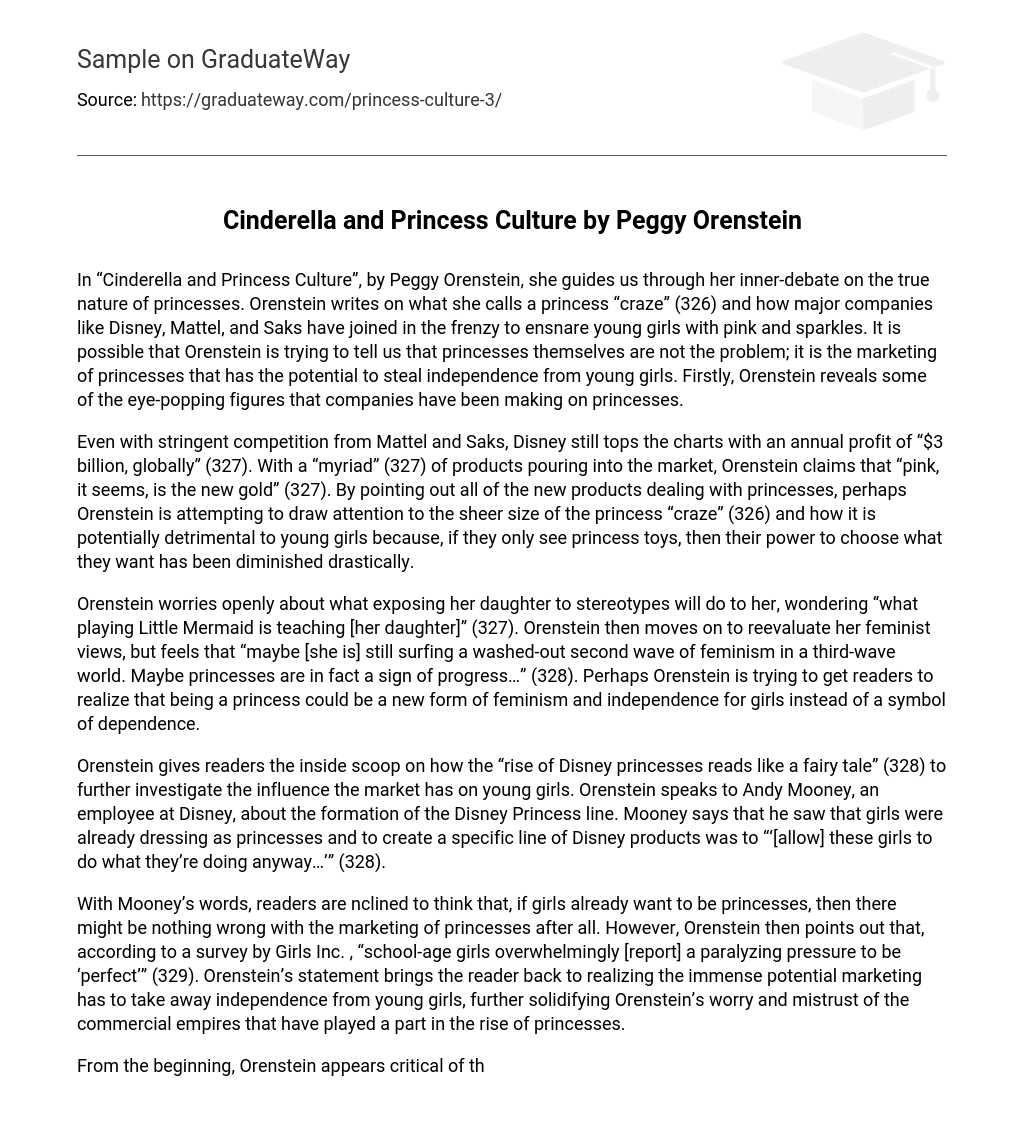In “Cinderella and Princess Culture”, by Peggy Orenstein, she guides us through her inner-debate on the true nature of princesses. Orenstein writes on what she calls a princess “craze” (326) and how major companies like Disney, Mattel, and Saks have joined in the frenzy to ensnare young girls with pink and sparkles. It is possible that Orenstein is trying to tell us that princesses themselves are not the problem; it is the marketing of princesses that has the potential to steal independence from young girls. Firstly, Orenstein reveals some of the eye-popping figures that companies have been making on princesses.
Even with stringent competition from Mattel and Saks, Disney still tops the charts with an annual profit of “$3 billion, globally” (327). With a “myriad” (327) of products pouring into the market, Orenstein claims that “pink, it seems, is the new gold” (327). By pointing out all of the new products dealing with princesses, perhaps Orenstein is attempting to draw attention to the sheer size of the princess “craze” (326) and how it is potentially detrimental to young girls because, if they only see princess toys, then their power to choose what they want has been diminished drastically.
Orenstein worries openly about what exposing her daughter to stereotypes will do to her, wondering “what playing Little Mermaid is teaching [her daughter]” (327). Orenstein then moves on to reevaluate her feminist views, but feels that “maybe [she is] still surfing a washed-out second wave of feminism in a third-wave world. Maybe princesses are in fact a sign of progress…” (328). Perhaps Orenstein is trying to get readers to realize that being a princess could be a new form of feminism and independence for girls instead of a symbol of dependence.
Orenstein gives readers the inside scoop on how the “rise of Disney princesses reads like a fairy tale” (328) to further investigate the influence the market has on young girls. Orenstein speaks to Andy Mooney, an employee at Disney, about the formation of the Disney Princess line. Mooney says that he saw that girls were already dressing as princesses and to create a specific line of Disney products was to “‘[allow] these girls to do what they’re doing anyway…’” (328).
With Mooney’s words, readers are nclined to think that, if girls already want to be princesses, then there might be nothing wrong with the marketing of princesses after all. However, Orenstein then points out that, according to a survey by Girls Inc. , “school-age girls overwhelmingly [report] a paralyzing pressure to be ‘perfect’” (329). Orenstein’s statement brings the reader back to realizing the immense potential marketing has to take away independence from young girls, further solidifying Orenstein’s worry and mistrust of the commercial empires that have played a part in the rise of princesses.
From the beginning, Orenstein appears critical of the princess “craze” (326) and the monstrous marketing machine that has risen up beside it. Orenstein wonders, however, whether or not being a princess is truly bad for a girl’s ability to remain independent, but this thought does not last. As Orenstein’s thoughts draw to a close, it is apparent that she has made no definite conclusions about princesses, marketing, and who is to blame. Perhaps readers can take away the thought that, even with the market still looming over girls’ heads, there is still the potential to be an independent princess.





